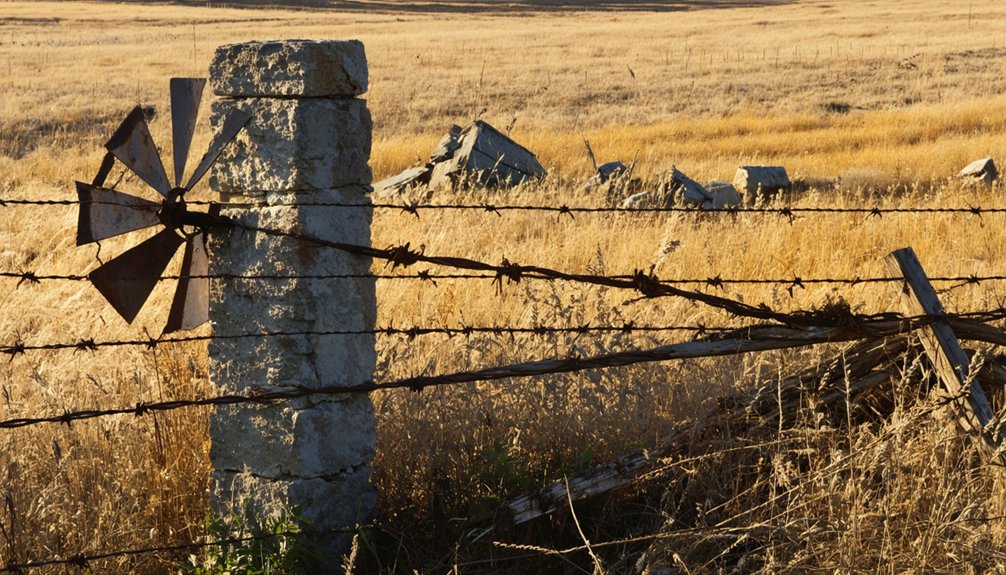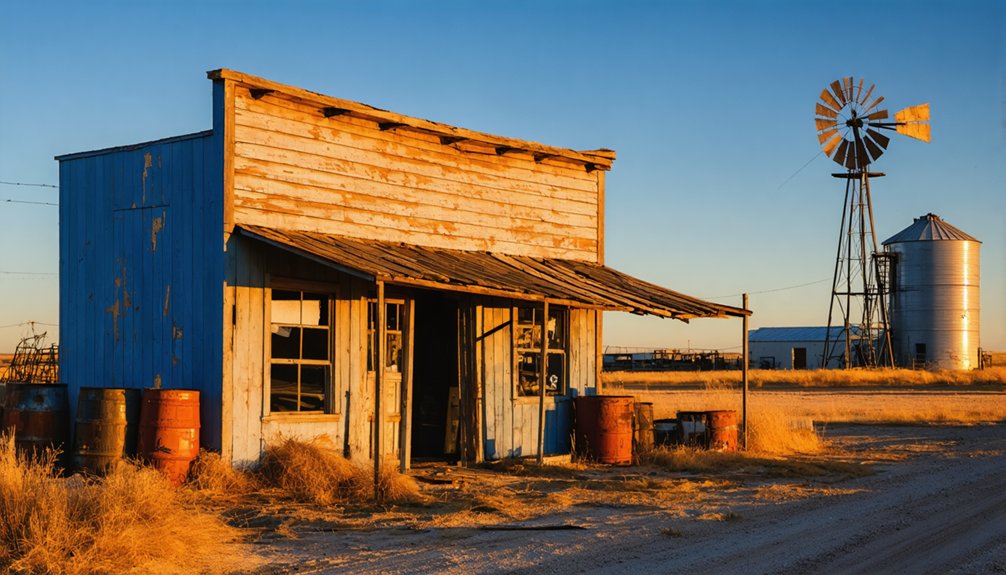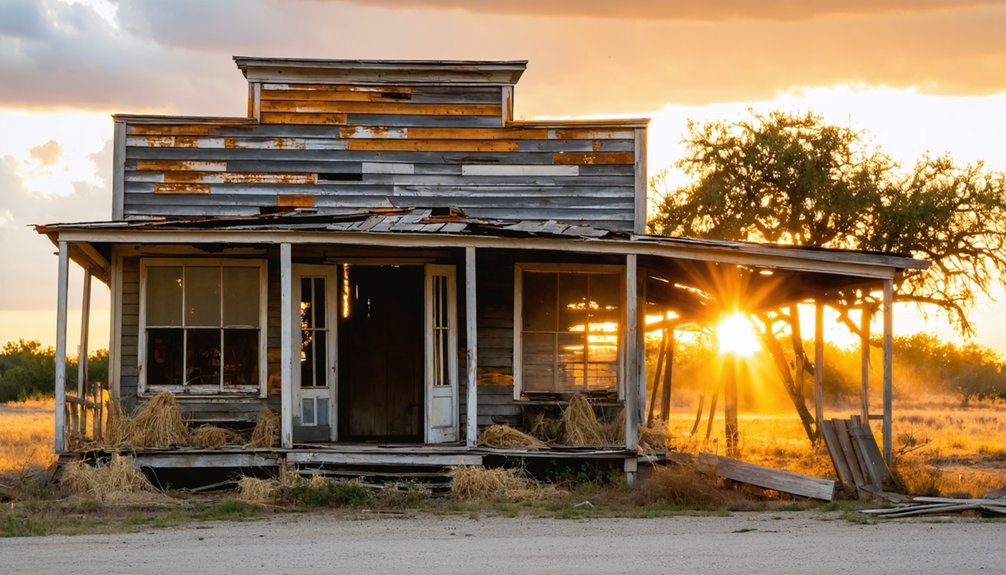You’ll find Woodward’s ghost town origins at Plemons Crossing, an essential Canadian River crossing point in the Texas Panhandle. The settlement thrived as a farming and ranching hub until April 9, 1947, when a devastating F5 tornado struck, killing 169 people and destroying over 100 city blocks. The $9.7 million in damages triggered an exodus, with closed businesses, abandoned schools, and crumbling community networks. Today, remnants like the sawmill pond dam tell a story of nature’s power over human ambition.
Key Takeaways
- Woodward began as Plemons Crossing, a vital Canadian River crossing point in Texas, serving as a regional hub for travel and trade.
- The devastating 1947 F5 tornado destroyed over 100 city blocks, causing 169 deaths and triggering the town’s eventual decline.
- Economic collapse followed the tornado, with property values dropping 50% and essential services like schools and healthcare facilities disappearing.
- The town’s final decline accelerated after closing its last school in 1962, followed by post office and train depot shutdowns.
- Historical remnants include the sawmill pond dam, church ruins, and school foundations, marking where this once-prosperous community thrived.
Origins and Early Settlement
While many Texas ghost towns began as mining camps or railroad stops, Woodward’s origins trace back to a significant Canadian River crossing point known as “Plemons Crossing.”
While railroads and mines birthed many Texas ghost towns, Woodward began at Plemons Crossing, a vital Canadian River passage.
The site earned its name from Barney Plemons, who established a crossing service after discovering his horse could detect dangerous quicksand patches in the river.
As word spread about this safe passage, early commerce began to flourish around the crossing point. You’d have found traders, travelers, and settlers gathering at this strategic location, leading to the establishment of shops and residences.
The settlement’s name eventually shortened to “Plemons” as it grew beyond its original purpose. The town’s position in the Texas Panhandle made it a natural hub for regional travel and trade, connecting it to the broader network of frontier settlements. The community experienced rapid development in its early years as more people settled in the area. Like the coal mining town of Thurber, the area was encircled with barbed wire fencing to control access to the settlement.
Life in the Texas Panhandle
Living in the Texas Panhandle meant adapting to its challenging borderline humid subtropical to cool semi-arid climate, where you’d experience hot summers and unpredictable winters.
In this vast region spanning 25,610 square miles, you’d find yourself amid a rural lifestyle defined by dryland farming and cattle ranching, with annual rainfall barely reaching 21.5 inches.
Your agricultural practices would need to align with the region’s demanding conditions, focusing on drought-resistant crops like wheat, cotton, and sorghum.
Life centered around small, tight-knit communities where annual fairs and rodeos celebrated the farming heritage.
The region’s distinctive elongated protrusion shape emerged as a result of colonial border negotiations and territorial expansion.
You’d face the realities of limited healthcare and education access, while watching the landscape change dramatically from the 4,700-foot elevations in the northwest to 2,000 feet in the southeast, all while battling the persistent winds across the High Plains.
The area experiences an average of fifteen tornadoes annually, making severe weather preparedness an essential part of daily life.
The Devastating 1947 Tornado
The tranquil rural life of the Texas Panhandle changed forever on April 9, 1947, when one of America’s deadliest tornadoes carved a devastating path through the region.
The massive F5 tornado first touched down southeast of White Deer at 5:42 p.m., growing to an incredible width of 1.8 miles as it raced northward at 50 mph. The tornado’s destructive power was so intense that a 20-ton steel boiler was thrown a block and a half.
The tornado’s aftermath left an unprecedented trail of destruction across three states, claiming 169 lives and injuring 980 people. Rescue efforts were severely hampered by cold and snow conditions.
In Woodward alone, over 100 city blocks were reduced to rubble. The disaster response drew support from across the nation as communities struggled to rebuild from $9.7 million in damages.
You’ll find this tornado’s impact reached far beyond physical destruction – it revolutionized weather forecasting and forever changed how Americans prepare for severe storms.
Impact on Local Communities
Following the devastating 1947 tornado, Woodward’s local communities experienced profound socioeconomic upheaval that persists today.
You’ll find that the town’s economic foundation crumbled as critical industries vanished, triggering a destructive cycle of job losses and population decline. Housing values have plummeted by up to 50%, while vacancy rates exceed 20% in many neighborhoods. The town’s decline mirrors many Texas rural communities struggling with outmigration and limited opportunities. Monthly rental rates have seen dramatic reductions, similar to Raymondville where two-bedroom units dropped from $850 to $640.
The erosion of community resilience is evident in the disappearance of essential services. Schools struggle to maintain programs, and healthcare facilities have shuttered their doors.
Essential services vanish as community resilience fades, with schools and healthcare facilities struggling to survive amid mounting challenges.
Social innovation has proven challenging as younger generations move away, leaving behind an aging population. You’ll notice the strain on public services as the tax base continues to shrink, making it harder to maintain infrastructure and support the remaining residents who’ve chosen to stay.
Path to Abandonment
The devastating F5 tornado of 1947 struck Woodward’s community with such force that you’d see its destructive impact ripple through the town’s physical and social fabric. The storm’s path of devastation extended to neighboring Laverne, Texas, which was completely annihilated in its wake.
You’ll notice how the storm’s aftermath accelerated existing economic troubles, as businesses closed their doors and residents left to find work elsewhere when rebuilding proved too costly.
As families departed, you’d watch the town’s essential services and community networks crumble, making it increasingly difficult for remaining residents to maintain any semblance of normal life. Today, like many of the over 1,000 ghost towns scattered across Texas, Woodward stands as a silent testament to dreams unfulfilled.
Natural Forces Take Hold
As natural forces gained dominance over Woodward’s abandoned landscape, persistent high winds and severe weather patterns began systematically dismantling the town’s remaining structures.
Wind erosion stripped paint from buildings while swirling dust storms gradually wore down exposed surfaces. You’ll find crumbling concrete where sidewalks once guided residents through their daily routines.
Nature’s reclamation accelerated as vegetation encroachment took hold. Native cacti and wild grasses pushed through cracks in foundations and pavement, while fallen trees contributed to the scene of desolation.
The town’s isolation deepened as access roads deteriorated and natural barriers formed. Where streets once bustled, you’ll now see only the relentless cycle of nature consuming what humans left behind, with weather-worn remnants slowly disappearing beneath the Texas plains.
Economic Decline Accelerates Exodus
Woodward’s economic foundation crumbled long before nature began its conquest of the town. When local industries failed and jobs disappeared, residents faced harsh realities that triggered economic migration to more prosperous areas.
The town’s decline mirrored the pattern seen across rural Texas, where single-industry dependence led to catastrophic consequences once that industry faltered.
- Housing prices plummeted as inventory flooded the market, with abandoned homes becoming common sights.
- Local businesses shuttered as customer bases shrank, eliminating crucial services.
- Young families left in search of better opportunities, accelerating rural depopulation.
- Essential infrastructure deteriorated without proper funding and maintenance.
The exodus created a devastating cycle: fewer residents meant less tax revenue, leading to reduced services and making the town even less attractive to potential newcomers or investors.
Community Networks Break Down
Once vibrant social networks began unraveling in 1962 when Woodward’s last school closed its doors, triggering a cascade of institutional failures that would destroy the town’s social fabric.
You’d soon witness the post office and train depot shuttering, severing essential daily connection points among neighbors.
The social disintegration accelerated as churches, clubs, and cooperatives disbanded, eliminating structured venues where residents once gathered and supported each other.
Community isolation intensified when utility services failed and communication networks broke down.
As younger generations fled and families scattered, the remaining residents found themselves cut off from meaningful social contact.
The physical decay of parks and meeting halls mirrored the collapse of volunteer groups and mutual aid networks, while transient populations and widespread outmigration eroded what little trust remained among neighbors.
Traces Left Behind

Several significant traces remain from the former timber boomtown of Woodward, anchored by the still-standing sawmill pond dam that serves as a key landmark for visitors.
The architectural remnants and social infrastructure paint a picture of a once-thriving community, with the preserved mill manager’s Gibbs house now operating as a bed-and-breakfast.
You’ll find scattered evidence of the town’s former liveliness in the ruins of industrial and community structures.
- The sawmill site contains charred remnants from the devastating 1935 fire that ended operations
- Former locations of the church, school, and commissary reveal the town’s social framework
- The dam and pond area continues to support recreational activities like fishing
- Concrete foundations and scattered brick ruins mark where key buildings once stood
Natural Disasters and Ghost Towns
While many Texas ghost towns faded gradually due to economic decline, natural disasters often delivered the final blow that sealed their fate.
You’ll find that catastrophic hurricanes along the Gulf Coast and devastating tornadoes in the Panhandle forced entire communities to make tough choices about disaster recovery. The 1875 hurricane’s destruction left survivors wondering whether to rebuild, while the 1947 F5 tornado that leveled Glazier demonstrates how nature’s fury can erase towns overnight.
Environmental resilience played a key role in determining which communities survived.
Towns already struggling economically rarely bounced back after disasters struck. When faced with rebuilding churches, schools, and homes, younger families often chose to relocate, leaving only scattered ruins and memories behind.
Regional Economic Changes

Beyond nature’s destructive forces, economic shifts fundamentally shaped Woodward’s destiny. The town’s early reliance on coal mining and lumber created initial prosperity, but these industries couldn’t sustain long-term growth.
Woodward’s early prosperity from coal and timber proved unsustainable, highlighting how economic dependencies can determine a town’s fate.
When petroleum exploration began in 1903, you’d see brief economic booms that teased the town’s potential but never delivered lasting success. Transportation shifts, particularly the rise of automobiles, disrupted traditional trade patterns and changed how people accessed the town.
- A significant gas well discovery in 1956 temporarily boosted the local economy
- The 1975 iodine extraction plant provided 14% of America’s iodine supply
- Population declined from 14,383 to 13,902 between 1950-1960 despite oil activity
- Transportation changes, especially automobile accessibility, altered regional trade routes
Legacy in Texas History
Despite its brief existence, Woodward left an indelible mark on Texas history as a demonstration of the boom-and-bust cycles that characterized frontier settlements.
You’ll find its story deeply intertwined with Oklahoma’s Woodward, particularly following the devastating 1947 tornado that affected both communities.
The town’s remnants now serve as a symbol of the resilience of early Texas settlers while offering significant cultural heritage value through its architectural ruins and foundations.
Today, you can explore Woodward’s tourism potential through its physical remains, which provide essential insights into early 20th-century rural life.
The site’s legacy continues to attract historians, photographers, and adventure seekers, contributing to Texas’s rich ghost town lore and offering opportunities for heritage preservation and educational development.
Frequently Asked Questions
Are There Any Known Photographs of Woodward, Texas Before Its Destruction?
You won’t find any confirmed historic imagery of pre-destruction Woodward. While visual documentation from Texas ghost towns exists, there’s no evidence of photographs showing this specific town before it vanished.
What Was the Estimated Peak Population of Woodward, Texas?
Like finding a flip phone in 1890, you won’t discover a verified peak population for Woodward. Historical significance appears minimal, as no credible records document the ghost town’s numbers.
Did Any Original Families From Woodward Remain in the Surrounding Area?
You’ll find that while original families didn’t stay in Woodward itself, their descendants maintained family histories and legacy connections through cemeteries, reunions, and settlements in neighboring towns after the 1947 tornado.
Were There Any Attempts to Rebuild Woodward After the Tornado?
Purposeful pioneers pushed forward with rebuilding efforts, showing remarkable community resilience. You’ll find that Woodward successfully reconstructed, unlike nearby Glazier, and continued as a thriving city through determined reconstruction work.
What Businesses or Industries Operated in Woodward Before Its Abandonment?
You’d find coal mining and brick manufacturing dominated the area, with the Texas & Pacific Railway’s heavy railroad influence shaping the economy until economic decline led to closures in the 1930s.
References
- https://texascooppower.com/old-haunts/
- https://www.youtube.com/watch?v=WOKT6iPqDkk
- https://texashighways.com/travel-news/four-texas-ghost-towns/
- https://www.youtube.com/watch?v=phjUE19A8HM
- https://www.southernthing.com/ruins-in-texas-2640914879.html
- https://en.wikipedia.org/wiki/List_of_ghost_towns_in_Texas
- https://www.texasescapes.com/TexasGhostTowns/Glazier-Texas.htm
- https://mix941kmxj.com/the-strange-sad-story-of-a-texas-ghost-town-youll-never-visit/
- https://www.tarleton.edu/the-industrious-historian/2011/01/23/the-gravestone-of-a-ghost-town/
- https://texashighways.com/culture/history/what-the-heck-is-a-ghost-town/



